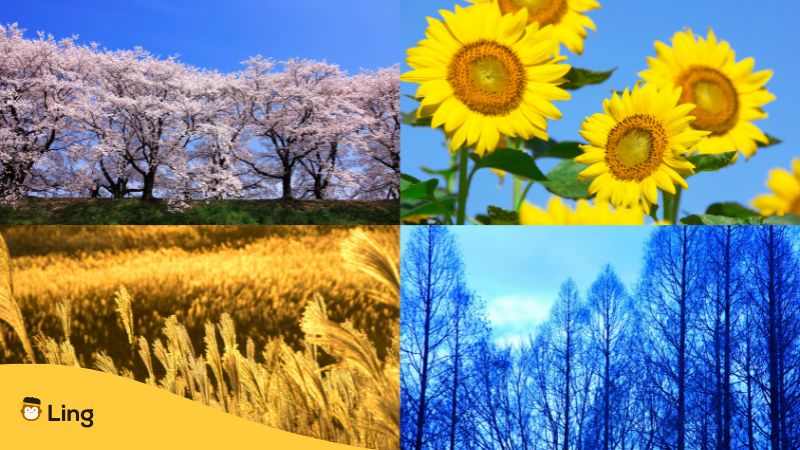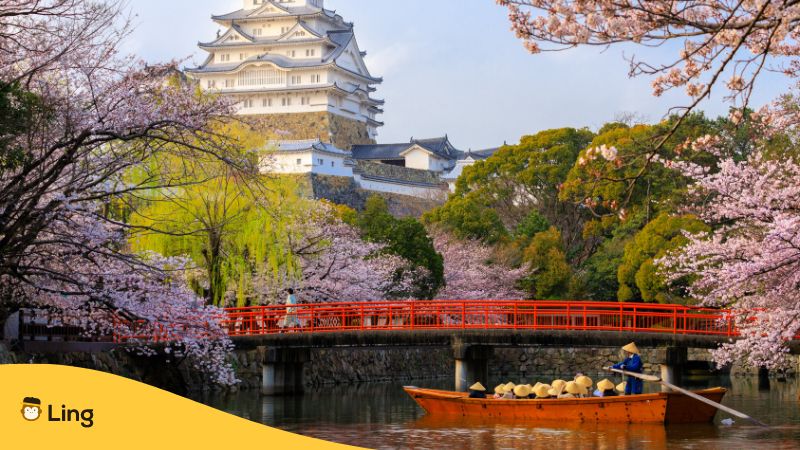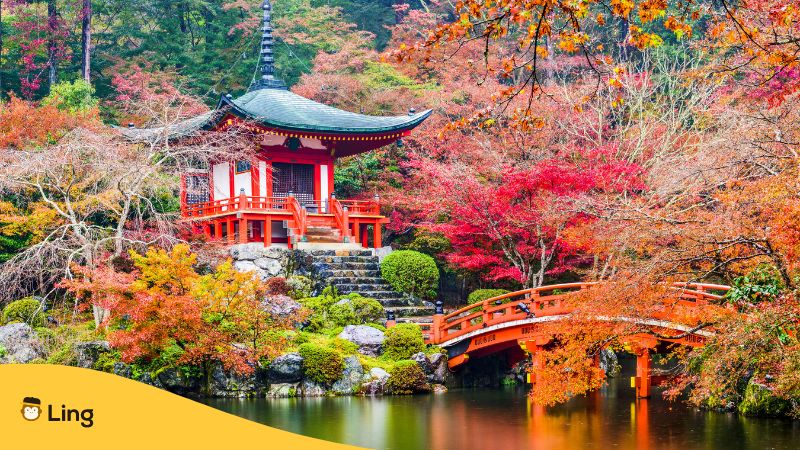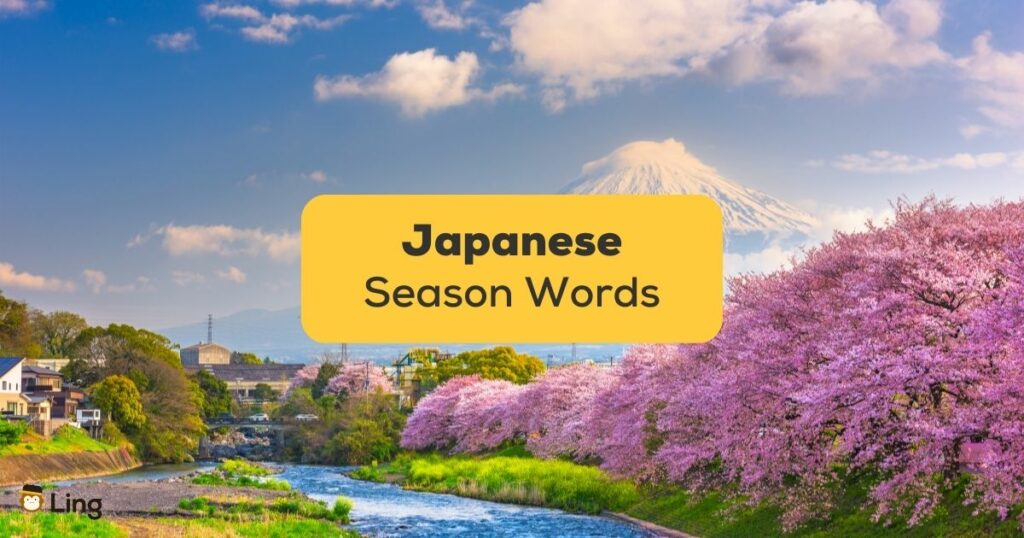Wondering about the Japanese season words? The beauty of Japan’s seasons is not only reflected in its stunning landscapes and Instagrammable cherry blossoms but also in the language used to describe them. The Japanese language is filled with 季語 (kigo) or season words that capture the essence of each season, providing a unique perspective on the changing natural wonders. In this article, we will explore Japanese words that are closely associated with the four seasons of Japan. Let’s begin!
Is Japan a part of your bucket list? If yes, then you know what I mean when I say that I feel a little giddy every time I close my eyes and dream of being in the center of Shinjuku Gyoen during the cherry blossom season. It’s like watching a magical transformation unfold before your eyes! It’s as if those delicate pink petals dance in the breeze, reeling you into a scene that looks like it’s straight out of the anime.
And it’s not just that season that each of us is looking after! I bet many of you are also dreaming of spending the summer season, winter morning, and autumn rain as well. While the flights going to this country can be pretty pricey, one thing that may help you still enjoy the Japanese seasons is by embracing the kigo.
Let’s get to know more about this below!

What Is Kigo?
Kigo, a fundamental concept in Japanese literature and poetry, refers to the seasonal words or expressions that capture the essence of each season. It’s a linguistic tool that adds depth, symbolism, and cultural significance to the written and spoken word. By incorporating some of these words into their compositions, Japanese writers and poets evoke a vivid sense of time, place, and emotion, making their works resonate with readers on a profound level.
From the way I see it, the purpose of kigo is not merely to describe the seasons but to engage readers in a sensory and intellectual experience. Each kigo carries a wealth of associations, drawing upon shared cultural knowledge and experiences. These words act as gateways, allowing readers to transport themselves to specific moments in time and connect with the deeper meaning of the text.
For example, the word “sakura” instantly conjures images of delicate cherry blossoms in full bloom, signaling the arrival of spring. But Kigo takes it a step further by encompassing the beauty, transience, and profound symbolism associated with this annual phenomenon. The mere mention of “sakura” sparks a cascade of emotions, representing renewal, fleeting moments of beauty, and the ephemeral nature of life itself. Sound pretty dramatic, don’t you think?
But here’s the thing: Kigo isn’t limited to specific nouns!
It can also be expressed through verbs, adjectives, and phrases, capturing the essence of a season in a more abstract way. For instance, the phrase “natsu-yasumi” signifies summer vacation and encapsulates the sense of freedom, leisure, and carefree enjoyment associated with the season. Similarly, “momijigari” encompasses the act of seeking out and appreciating the vibrant colors of autumn foliage, inspiring a sense of awe and reverence for nature’s transformative beauty.
By using kigo, we invite people to explore the interconnectedness between nature, culture, and human experience. It fosters a deeper appreciation for the ever-changing rhythms of the natural world and encourages reflection on the fleeting moments that make life so precious.
Japanese Season Words
There’s no denying that Japan’s rich natural beauty has inspired poets, artists, and writers for centuries. The language itself reflects this deep appreciation for nature, with specific words dedicated to each season. Let’s dive into some of the most evocative Japanese words that encapsulate the essence of spring, summer, autumn, and winter.

Spring Season Words
Sakura
Sakura, meaning cherry blossoms, is an iconic symbol of Japan and represents the arrival of spring. These delicate flowers bloom for a short period, painting the landscape with shades of pink and white. The blooming of sakura is celebrated with hanami, a traditional custom of enjoying picnics under cherry blossom trees.
Hanami
Hanami directly translates to “flower viewing” and refers to the Japanese tradition of admiring cherry blossoms during springtime. It is a joyful occasion when friends and families gather in parks, gardens, and along riverbanks to appreciate the fleeting beauty of sakura. Hanami is often accompanied by food, drinks, and lively conversations.
Haru Ichiban
Haru Ichiban, meaning “the first wind of spring,” represents the arrival of a gentle breeze that carries the warmth and fragrance of the season. It marks the end of the cold winter and the beginning of new life. Haru Ichiban is a refreshing and invigorating wind that fills the air, bringing a sense of hope and renewal.

Summer Season Words
Natsu-yasumi
Natsu-yasumi translates to “summer vacation” and is eagerly anticipated by students and workers alike. It is a time for rest, relaxation, and enjoying various summer activities. Natsu-yasumi often involves trips to the beach, festivals, and spending quality time with family and friends.
Mizu-yōkan
Mizu-yōkan is a traditional Japanese sweet made from agar, sugar, and red bean paste. It is a popular treat during the hot summer months. Mizu-yōkan is typically chilled and has a jelly-like texture, providing a refreshing and cooling sensation when consumed.
Umi
Umi simply means “sea” in Japanese. With its extensive coastline and numerous islands, Japan is blessed with an abundance of beautiful beaches and crystal-clear waters. During the summer season, many people flock to the seaside to enjoy water sports, sunbathe, and relax by the ocean.

Autumn Season Words
Momijigari
Momijigari refers to the traditional activity of viewing and appreciating the vibrant autumn foliage. As the leaves change color, forests, and mountains transform into a breathtaking palette of red, orange, and yellow. Momijigari often involves hiking or visiting famous autumn leaf spots to immerse oneself in the beauty of nature’s transition.
Tsukimi
Tsukimi translates to “moon-viewing” and is a Japanese tradition held in autumn. During this time, people gather to appreciate the full moon and celebrate the beauty of the lunar illumination. Tsukimi often involves enjoying seasonal food and creating decorations inspired by the moon.
Aki no Sora
Aki no Sora means “autumn sky” and represents the clear, crisp sky that characterizes the autumn season. As the humidity of summer fades away, the sky becomes a vivid blue backdrop for the colorful foliage. Aki no Sora evokes a sense of tranquility and awe-inspiring beauty.

Winter Season Words
Yuki
Yuki simply means “snow” in Japanese. Japan experiences heavy snowfall in many regions during the winter months, transforming landscapes into serene and picturesque scenes. Yuki is associated with various winter activities such as skiing, snowboarding, and building snowmen.
Kotatsu
Kotatsu is a traditional Japanese heating appliance used during the cold winter months. It consists of a low table with a heating element underneath and a blanket or futon draped over it. Kotatsu provides warmth and comfort, inviting people to gather around it for cozy conversations or leisurely activities.
Fuyu no Yūbe
Fuyu no Yūbe translates to “winter evening” and captures the serene and peaceful atmosphere that descends with the setting sun during winter. Fuyu no Yūbe represents the quiet moments spent indoors, enjoying warm beverages and reflecting on the year that has passed.
Which Japanese Season Word Is Your Favorite?
Wow! You made it through this article! Now which of the words we covered above is your favorite? Let us know in the comments below.
Want to learn more about kigo to enhance your Japanese haiku? Then you’re in luck! Allow me to introduce you to a valuable resource known as the Saijiki. The Saijiki, also referred to as the 歳時記 in Japanese, is a special reference guide used by haiku poets to deepen their understanding and mastery of kigo.
In the world of haiku, where brevity and depth are celebrated, the Saijiki acts as a compass, pointing poets towards the sheer number of seasonal Japanese words and expressions. It serves as a comprehensive catalog, providing a curated collection of kigo associated with each season, specific months, and even particular days or events throughout the year.
According to the locals, the traditional Saijiki primarily focuses on kigo for haiku. However, modern adaptations cater to different forms of poetry and artistic expression. Some of the Saijiki produced these days even include visual representations, allowing for a more comprehensive and multidimensional approach to capturing the essence of seasons.
Want To Learn Japanese?
Are you ready to take your Japanese skills to the next level? Look no further than the Ling app! Developed by native speakers, the Ling app is designed to make language learning not only effective but also incredibly fun. Say goodbye to boring flashcards and hello to a gamified language-learning experience that will keep you engaged and motivated.
Imagine immersing yourself in a world where learning Japanese is as exciting as playing a game. With Ling, you can do just that! Explore interactive features and activities that transform your language study sessions into enjoyable and interactive adventures. Picture yourself mastering new expressions and vocabulary while having a blast anytime and anywhere.
If that sounds cool to you, then it’s time to give the Ling app a try. Signing up for a free account is your ticket to unlocking a world of language-learning possibilities. Whether you’re interested in Japanese or any of the other 60+ languages offered, Ling has got you covered. And with the app available for download on both the App Store and Play Store, you can have it conveniently on your favorite device.



































































